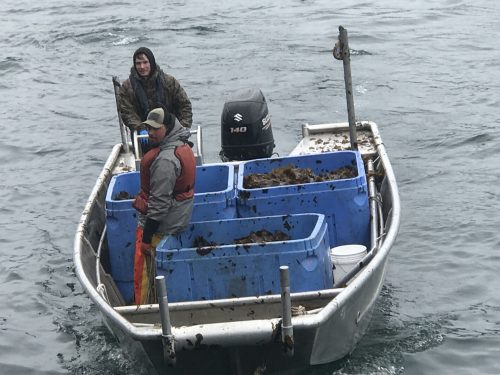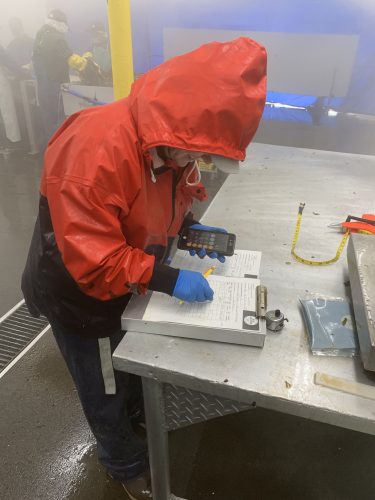Seaweed farmers in Alaska gear up for large haul
May 7, 2019
Paula Dobbyn
907-274-9698

The largest commercial harvest of seaweed in Alaska is taking place this month.
Blue Evolution, a California-based company that cultivates, harvests and distributes Alaska-grown seaweed, is expected to haul in up to 200,000 pounds from waters near Kodiak Island within the next two weeks. Previous harvests have been a fraction of that size, but, as the mariculture industry grows in Alaska, Blue Evolution is also expanding.
Working with local resident farmers, the company produces seed from wild seaweed plants and grows them into kelp starts in an onshore hatchery at the federal government's Alaska Fisheries Science Center Kodiak Laboratory. Blue Evolution then supplies seeded string to local farmers who plant them onto longlines in late fall, cultivate their crops during winter and harvest in spring.
The company is collaborating with the University of Alaska and Alaska Sea Grant on seaweed research aimed at developing cost-effective cultivation methods for several native species. Seaweed farming is a growing, multibillion-dollar industry worldwide and presents a new economic opportunity for coastal Alaska.
“It suits my family because we set gillnet for salmon during the summer and supplement our income with seaweed farming during winter,” said Lexa Meyer, who co-owns and operates Kodiak Kelp Co. with her husband.
Seaweed farming is taking off as a global industry that provides a nutritious, sustainable food source that is an alternative to terrestrial food products that often require lots of arable land, fresh water, antibiotics, fertilizers and pesticides, said Beau Perry, who founded and runs Blue Evolution. Perry described seaweed farming as “regenerative,” in that it creates additional nursery habitat for marine fauna, sequesters carbon dioxide and buffers the effects of ocean acidification. Although much of his company’s seaweed is grown in Mexico, Perry sees Alaska as an ideal place for aquatic farming to expand.

“There’s over 30,000 miles of coastline with pristine waters. The sea-to-table movement is growing as people want to know more about where their food comes from. Alaska is well-positioned to take advantage of this,” he said.
Rather than harvesting wild kelp, Perry sees Alaska’s opportunity in farming it out of regional hatcheries. It’s sustainable that way and does not disturb natural kelp beds which provide fish habitat.
Mariculture, which includes seaweed farming, is still a nascent industry in Alaska, but state officials report a growing number of permit applications over the past two years. The state recently created a mariculture development plan that aims to grow a $100 million industry within 20 years.
ON THE WEB: blueevolution.com; alaskaseagrant.org
NOTE TO EDITORS: Arrangements can be made for reporters to observe the seaweed harvest up close. High resolution photos are available.
ADDITIONAL CONTACTS: Beau Perry, founder and chief executive, Blue Evolution, 650-714-5540, beau@blueevolution.com. Lexa Meyer, Alaska mariculture manager and kelp farm owner/operator, 907-942-4366, lexa@blueevolution.com. Alf Pryor, commercial fisherman and kelp farm owner/operator, 907-942-1417, alfpryor@deadhumpy.com.


